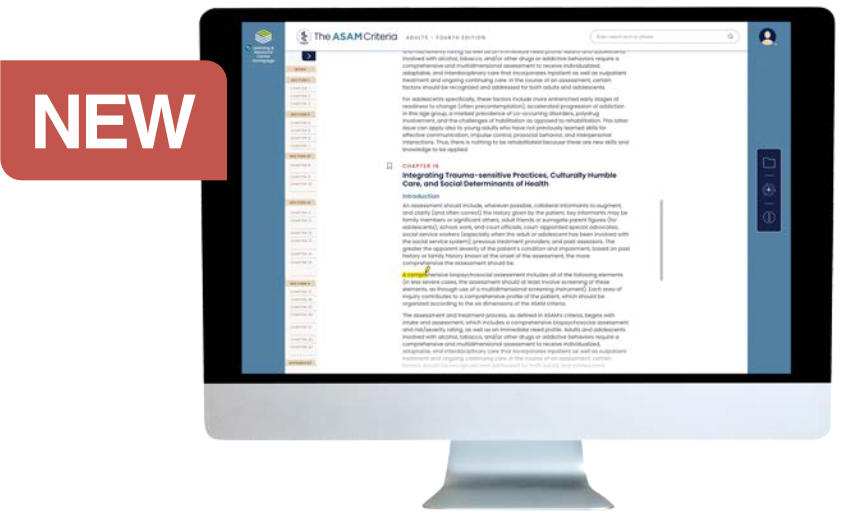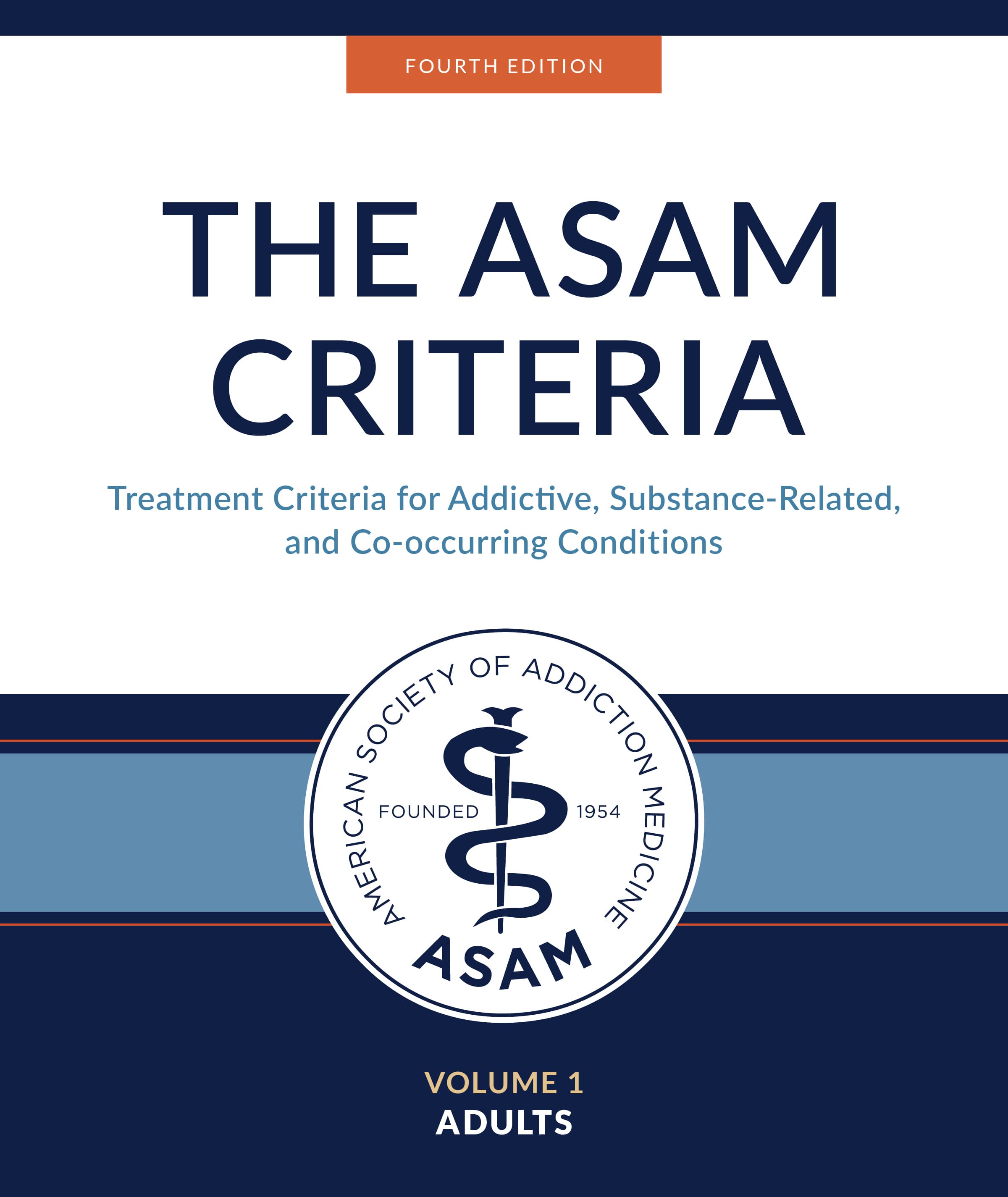Quality Care
The ASAM Criteria, 4th Edition
The ASAM Criteria Fourth Edition is a comprehensive set of guidelines that use a holistic, person-centered approach to developing treatment plans for patients with addiction and co-occurring conditions.
Buy Now Read Announcement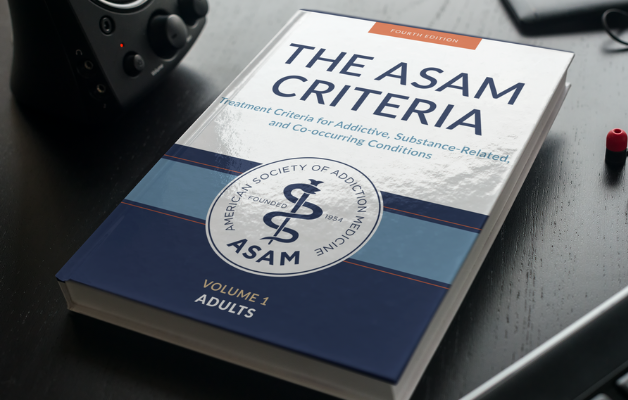
Call for Applications
Correctional Settings and Reentry workgroups
ASAM Criteria, Fourth Edition
We are accepting applications for expert writing group members to develop and draft the Correctional Settings and Reentry Volume of the Fourth Edition of The ASAM Criteria. Writing groups will provide expertise to develop the foundation for jail, prison, and reentry treatment standards and narrative content for the textbook.
Applications accepted until May 9, 2025
Fourth Edition Development
The Fourth Edition of The ASAM Criteria will be released in four volumes. Subsequent volumes will focus on adolescents and transition-age youth, justice-involved patients, and treatment of behavioral addictions (i.e., gambling, internet, and gaming addiction). The 4th Edition uses a rigorous methodology for evidence review and formal consensus development under the guidance of a new editorial subcommittee. Learn More
Call for Applications - Behavioral Addiction Volume Editors
ASAM is seeking experts in behavioral addictions (eg, problem gambling, internet/social media addiction, problem gaming, compulsive sex, pornography addiction, and food addition) to serve as Editors for the Fourth Edition of The ASAM Criteria®, Behavioral Addictions Volume. The Behavioral Addictions Volume of the Fourth Edition of The ASAM Criteria will propose principles for managing behavioral addiction and how the addiction treatment system can be organized to serve patients with these conditions.
Applications accepted until May 30, 2025.
Call for Applications - Adolescent Case Writers
We are seeking volunteers with experience working with adolescents to help sketch out adolescent case studies for The ASAM Criteria, Fourth Edition, Adolescent Volume. These case studies will be used to test the Dimensional Admission Criteria. Volunteers will be acknowledged in the contributors’ section of the Adolescent Volume.

The 4th Edition of The ASAM Criteria is available in print and digital versions to enable more effective implementation of The ASAM Criteria® in clinical practice.
4th Edition - Digital Version
The digital version brings the full value of The ASAM Criteria to life in an engaging and accessible interface.
Key features:
- Custom tools to highlight and bookmark content, create notes, and organize important information into folders
- Personalized dashboard allows you to enter the textbook where you left off and offers quick access to your saved materials
- Interactive graphics and multimedia enhance the learning experience
- Contextually relevant expert videos, case studies, and resources provide insights and support for using the clinical standards with your patients
- Regular updates deliver new supplementary resources as they become available
4th Edition - Print Version
The ASAM Criteria Fourth Edition is a comprehensive set of standards and decision rules that use a holistic, person-centered approach to determining the appropriate level of care and developing treatment plans for patients with addiction and co-occurring conditions.
The revised standards have been crafted using a rigorous methodology for scientific evidence review and consensus development. The result is an update that is easier to understand and apply for improved patient care.
New in this edition:
- Color-coding system organizes information into easily identifiable sections, facilitating quicker access to key content
- Redesigned charts and graphics distill complex concepts into simpler, clearer explanations
- Updated clinical standards reflect the current state of scientific evidence and clinical practice, and integrate more person-centered considerations when assessing the level of care.
What’s new in The ASAM Criteria, Fourth Edition?
Core Components of The ASAM Criteria
The ASAM Criteria standards include three core components that work in tandem when making level of care recommendations. As a patient enters addiction treatment an ASAM Criteria Level of Care Assessment is used to identify the patient’s clinical needs. The results of the assessment are applied to the Dimensional Admission Criteria to determine the recommended level of care.
The ASAM Criteria also define standards for the different levels of care across the continuum, describing the setting, staffing, service intensity and other core elements at each level of care
As a patient moves through treatment, they are regularly reassessed. The transition and continued service criteria are applied to determine if the patient is ready to move to a less intensive level of care, requires a more intensive level of care, or should continue at the current level of care.
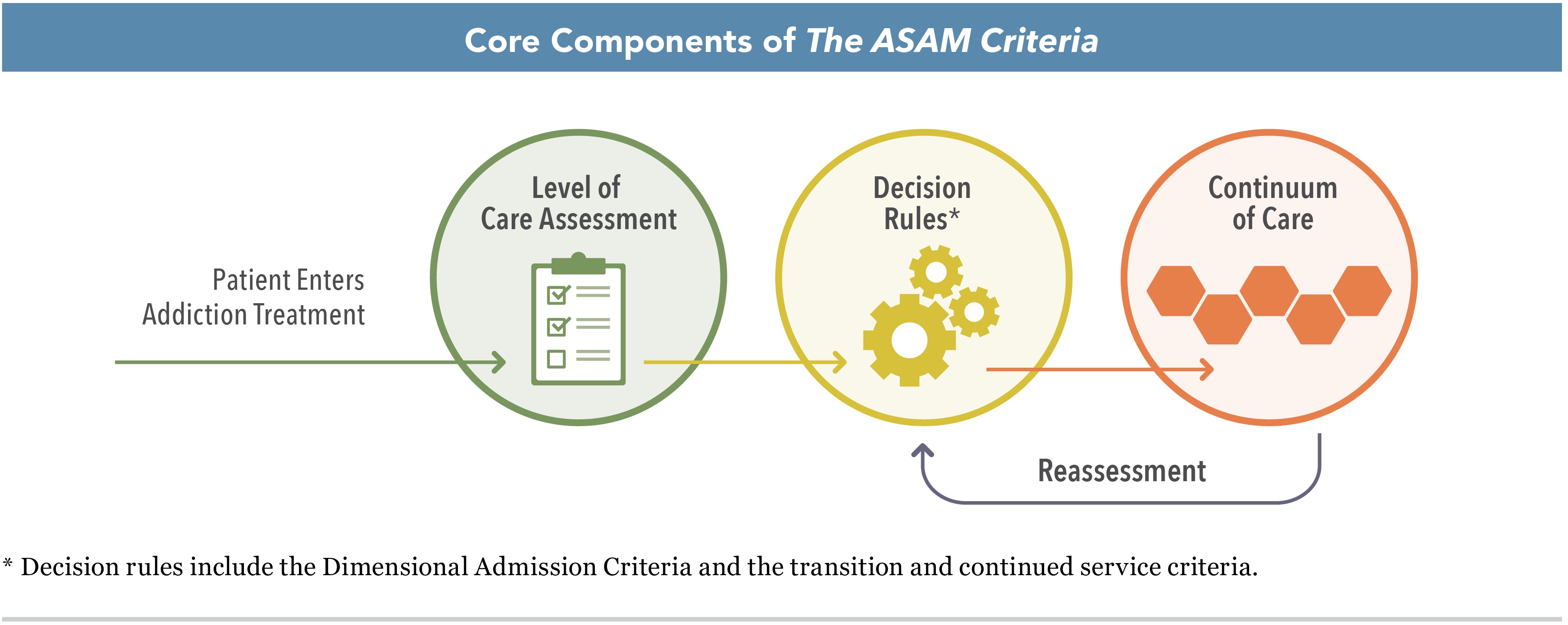
Updated Six Dimensions
The six dimensions of The ASAM Criteria were updated in the Fourth Edition. The Third Edition’s Dimension 4: Readiness to Change does not contribute independently to the recommended level of care; rather, it impacts clinical judgments related to risks in other dimensions and influences the services that should be delivered at any level of care and should be carefully considered in treatment planning.
The Fourth Edition reorders the dimensions such that consideration of readiness to change is integrated across dimensions and replaced by a new dimension, Dimension 6: Person-Centered Considerations. This new dimension considers barriers to care—including social determinants of health (SDOH)—patient preferences, and the need for motivational enhancement. The Fourth Edition also simplifies and updates dimension names to reflect the field’s evolving terminology and facilitate effective dissemination of these standards.
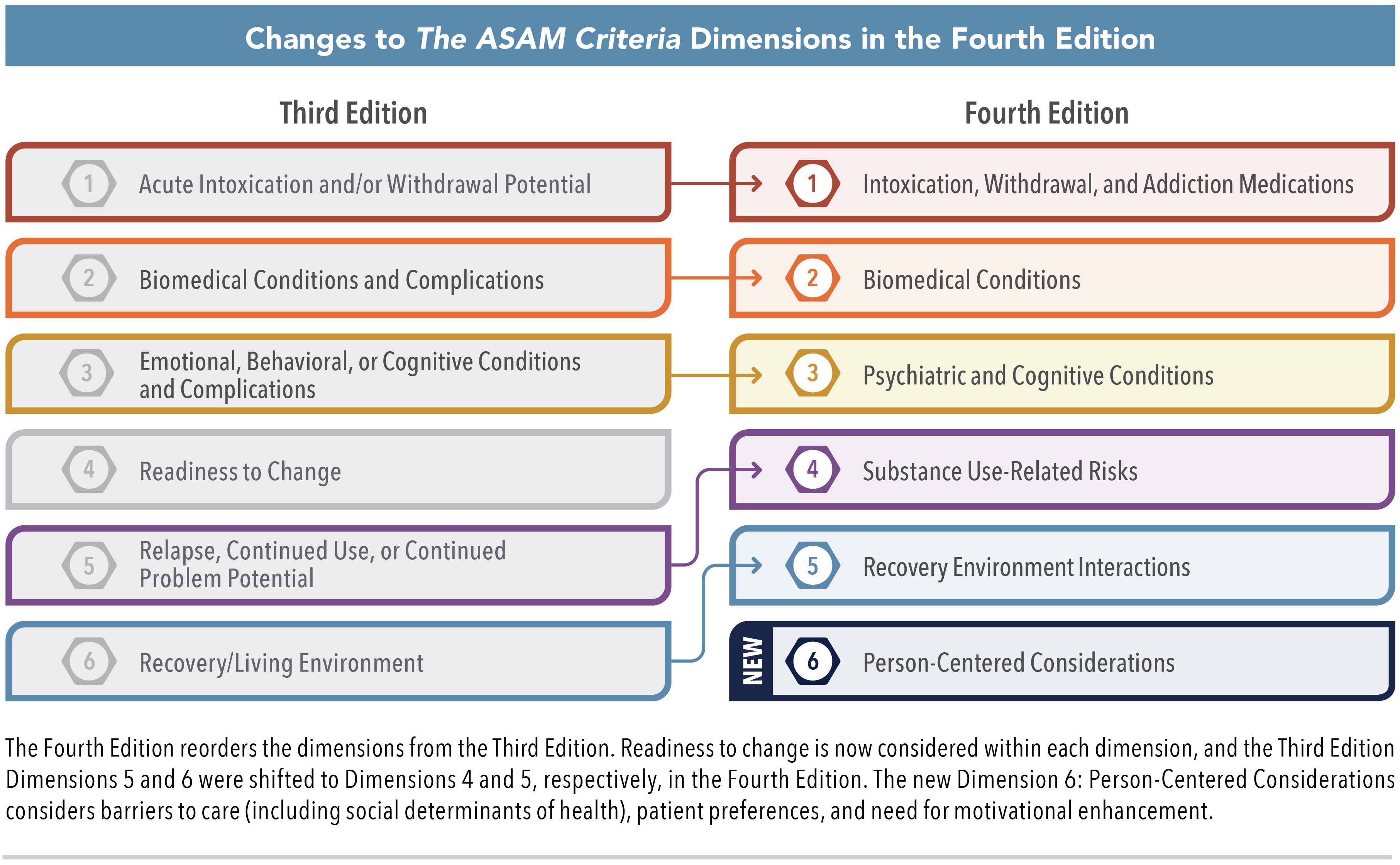
Newly Defined Subdimensions
The Fourth Edition describes subdimensions, reflecting core actionable factors, that should be assessed within each dimension. During the Level of Care Assessment, the subdimensions in bold and blue inform level of care recommendations and initial treatment for immediate needs; however, all subdimensions are considered for treatment planning purposes. Dimensions 1 through 5 are used to develop a level of care recommendation. When assessing Dimension 6, the assessor works with the patient using a shared decision-making framework to determine which level of care the patient is willing and able to engage in.
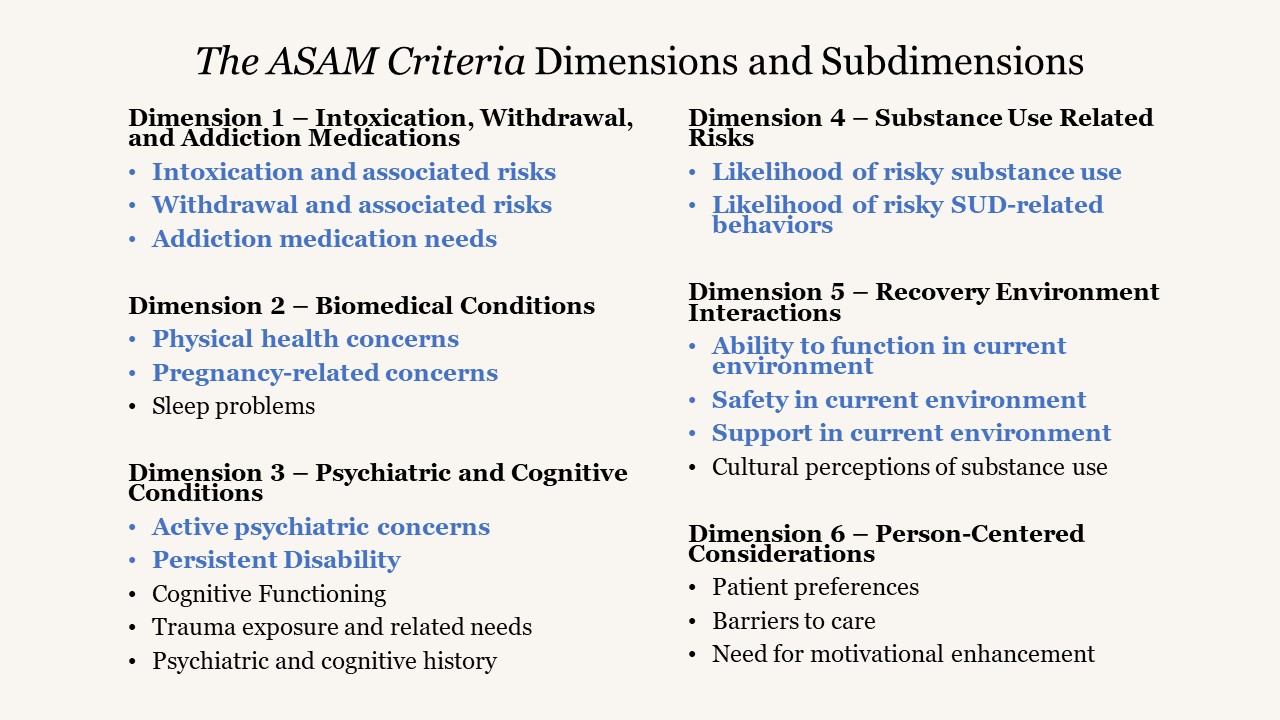
Updated Continuum of Care
The Continuum of care has also been updated in the Fourth Edition. The continuum still includes four broad treatment levels (1 through 4). And within these four broad levels of care, decimal numbers express further gradations of intensity and types of care provided. Major changes include:
- Integration of medically managed levels of care – which provide medical management for intoxication, withdrawal management and biomedical and psychiatric comorbidities – into the main continuum of care. The continuum also includes programs with enhanced biomedical capabilities (ie, Level 3.7 BIO) to manage patients with medical comorbidities and enhanced capabilities to treat patients with co-occurring mental health conditions (ie, co-occurring enhanced [COE] levels of care, which include Levels 1.5 COE, 1.7 COE, 2.5 COE, 2.7 COE, 3.5 COE, 3.7 COE, and 4 Psychiatric).
- A new Level 1.0 – Long-Term Remission Monitoring. This level of care provides long-term remission monitoring for patients in sustained remission, providing recovery management checkups and rapid reengagement in care when needed. This organization promotes a chronic care model of addiction treatment.
- The Dimensional Admission Criteria may recommend a recovery residence in addition to an outpatient level of care (ie, Levels 1 and 2).
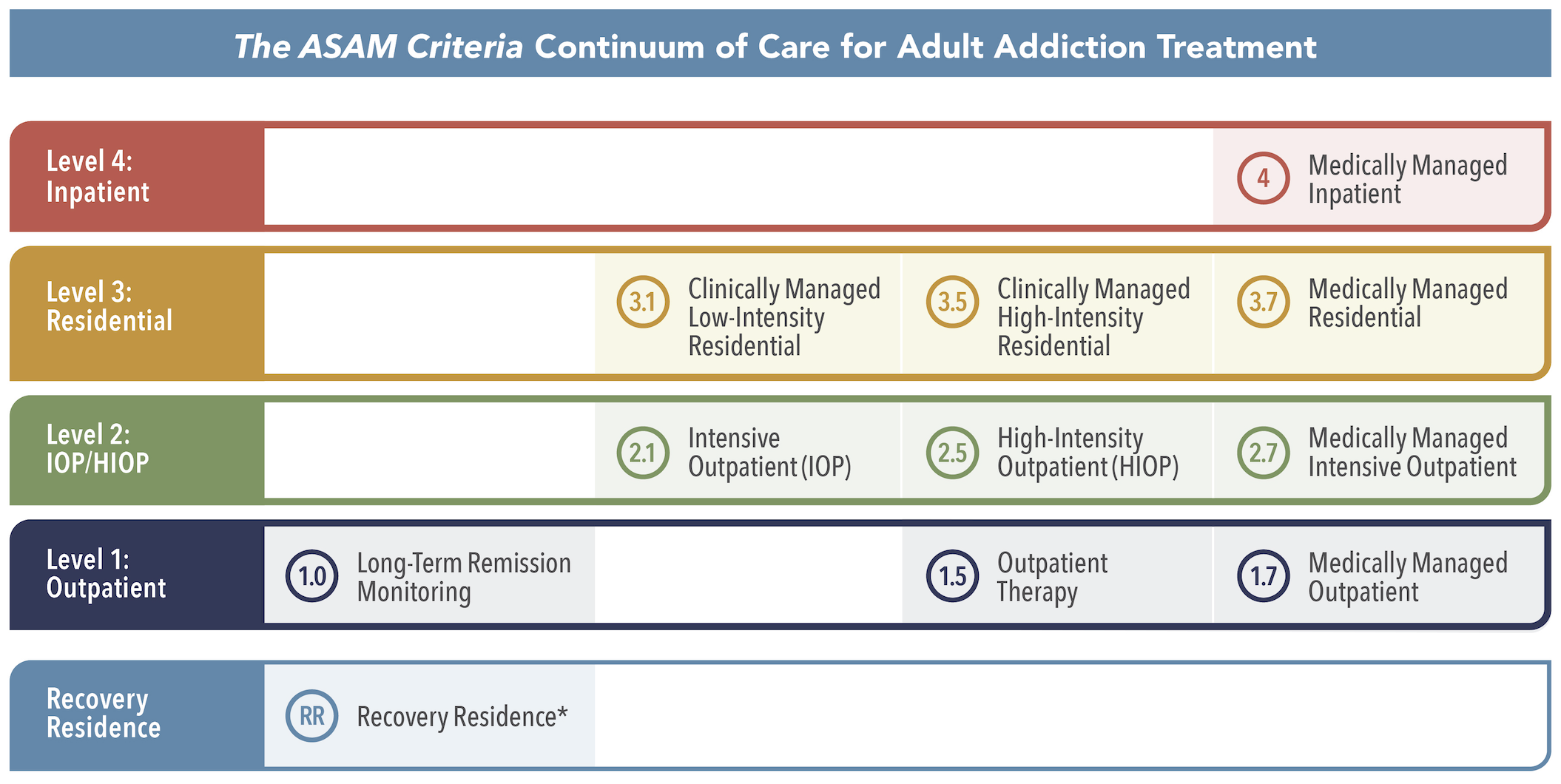
ASAM Criteria Software
Three software tools are currently available to support the implementation of The ASAM Criteria, including:
- ASAM CONTINUUM – a comprehensive electronic assessment tool that allows clinicians, counselors, and other staff to assess individuals with addictive substance use disorders and co-occurring conditions and leverage a computerized clinical decision support system (CDSS) to make level of care recommendations.
- ASAM Co-Triage – a computer-guided provisional referral tool designed to generate an initial level of care placement for individuals with substance use problems.
- The ASAM Criteria Navigator - ASAM has partnered with Optum to develop software for using The ASAM Criteria in utilization review and management workflows.
Training
ASAM offers live and online courses designed to meet the learning needs of multiple audiences in making use of the ASAM Criteria. Take an ASAM course or work with one of our endorsed trainers. Learn more
Implementation Tools
ASAM offers a variety of tools aimed at helping clinicians, payers, managed care entities, and policymakers implement The ASAM Criteria effectively.
Check out the ASAM Criteria Implementation Tools>>>

